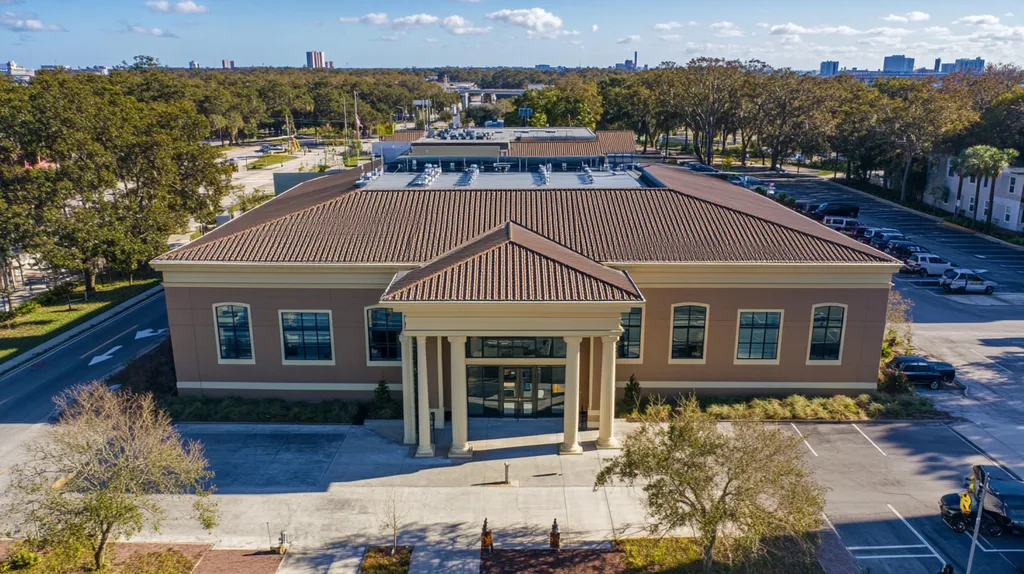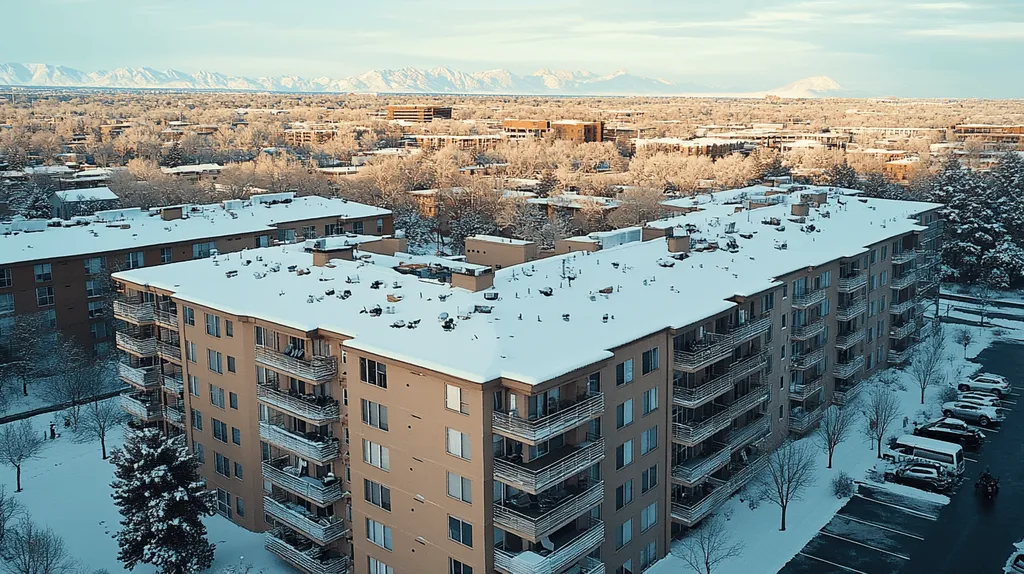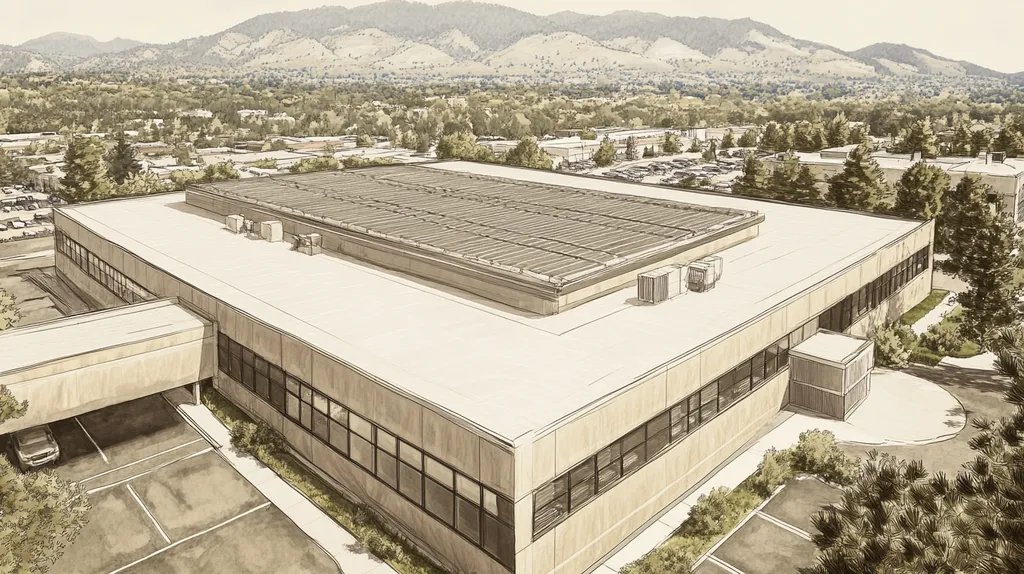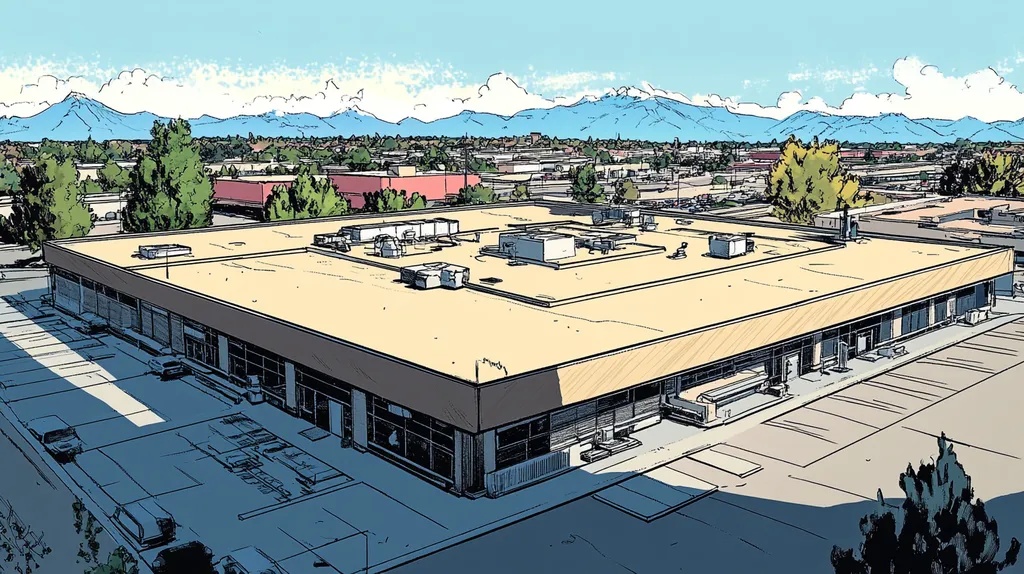When it comes to protecting commercial buildings, few decisions carry more weight than properly coating a sloped roof. Studies show that inadequate coating applications lead to 40% of all commercial roof failures, resulting in billions in repair costs annually.
From selecting the right materials to mastering application techniques, coating a sloped commercial roof requires careful attention to detail and deep technical knowledge.
This comprehensive guide breaks down the essential practices, common pitfalls, and expert techniques that ensure your roof coating project delivers maximum protection and return on investment.
SECTION 1: FUNDAMENTAL CONCEPTS
When it comes to sloped commercial roofs, applying coatings is more than just a maintenance chore; it’s a critical decision that directly impacts the building’s durability and efficiency. Choosing the wrong coating can lead to serious problems like leaks, soaring energy bills, and even structural damage. For property owners and facility managers, grasping the fundamental concepts behind roof coatings is vital for making well-informed choices. In this section, you’ll discover the types of coatings available, how to match them with different roof materials, and the essential influence of climate and weather on your roofing decisions.
Types of Commercial Roof Coatings
Commercial roof coatings are designed to safeguard roofs while prolonging their lifespan. With several types available, each boasting unique properties, understanding these distinctions is key. For example, acrylic coatings are a go-to choice for their UV resistance and straightforward application. On the other hand, silicone coatings excel in waterproofing, although they may struggle with standing water.
Polyurethane coatings are known for their exceptional abrasion resistance but require strict adherence to application guidelines. The right choice of coating hinges on the specific requirements of your building and its underlying roof material.
Each coating type offers distinct performance characteristics, making it vital to consider these differences. For instance, while acrylics may be budget-friendly, they might not perform optimally in extreme temperatures or during heavy rainfalls.
In the end, picking the appropriate coating is essential for reducing long-term maintenance costs and enhancing energy efficiency. Evaluating the various coating types lays the groundwork for effective roof protection strategies.
Roof Material Compatibility
The compatibility of roof coatings with existing roofing materials is pivotal for ensuring long-lasting results. Common substrates like TPO, EPDM, and modified bitumen each demand specific coatings for optimal adhesion. Opting for an incompatible coating could void warranties and cause premature failure.
For example, solvent-based coatings should never be applied to certain plastics, as they can inflict damage. Thus, conducting thorough research into your roof material is crucial before moving forward with any coating application.
Moreover, some coatings are engineered to enhance the existing materials’ properties. Take reflective coatings, for instance—they can boost energy efficiency and slash cooling costs when applied to darker roofs. Understanding the nuances of compatibility not only maximizes performance but can also lead to significant savings over time.
In summary, a careful assessment of roofing materials and how they interact with coatings is paramount. Compatibility is a major player in the success of any roofing project.
Climate and Weather Considerations
Local climate and weather patterns are critical factors when selecting the appropriate coating for sloped commercial roofs. In areas with heavy rainfall or snow, coatings that provide superior waterproofing and can endure freeze-thaw cycles are essential.
Conversely, hotter climates may benefit from reflective coatings that diminish heat absorption, ultimately cutting cooling costs. In cooler regions, coatings with strong thermal stability will help the roof withstand the challenges of fluctuating temperatures.
Additionally, factors such as humidity, wind, and exposure to intense UV radiation play important roles in coating selection. Moisture can hinder adhesion, and applying coatings during wet or extremely windy weather can lead to failures.
Every geographic region presents its own challenges, making a customized approach crucial. By understanding the local conditions, property owners can make informed decisions that ensure their investments remain protected for years to come.
SECTION 2: SYSTEM COMPONENTS
When applying coatings on sloped commercial roofs, the choice of system components isn’t just a detail—it’s a game changer for the roof’s longevity and performance. In a world where severe weather events are becoming increasingly common, property owners need to prioritize quality materials. Selecting and applying the right primers, coatings, and protective layers can make all the difference between a robust roof and a costly liability plagued by leaks and rapid deterioration.
Primer Selection and Application
The primer is the foundation for a successful coating application, ensuring a strong bond between the roof substrate and the coating. Picking the right primer can take the roof’s performance to new heights. For instance, water-based primers generally work well on a variety of substrates, while solvent-based primers shine on oily or intricate surfaces.
Application methods are equally critical. A smooth, even coat is essential for maximum adhesion and to prevent future failures. Rollers are great for covering large areas, but brushes are your best friend for detailed work around edges and seams.
Environmental factors can also affect primer effectiveness. Ideal temperatures usually range from 50°F to 90°F, and high humidity can interfere with cure times and overall adhesion.
Neglecting these factors could lead to headaches down the line. Property owners should always verify that the chosen primer is compatible with the coating materials to ensure lasting performance.
Coating Materials and Properties
The coating you select is vital for your roof’s durability and performance. Different coatings come with their own set of properties, such as UV resistance, waterproofing, and flexibility. For instance, acrylic coatings are champions at reflecting sunlight, while silicone coatings are all-stars in waterproofing.
Choosing the wrong coating can expose the roof to unnecessary vulnerabilities. Property owners need to consider local climate and building usage when making their selection, particularly in unique scenarios like coastal facilities that require saltwater resistance.
Additionally, the thickness of your coating plays a significant role in overall durability. Thicker applications can provide more robust protection but must be applied with care to prevent cracking or other issues. Adhering to manufacturers’ guidelines on thickness is essential for peak performance.
Ultimately, the right coating enhances the roof’s ability to withstand weather elements, reducing the frequency of repairs and extending its lifespan.
Additional Protective Layers
To build an exceptionally tough roofing system, adding protective layers is often necessary. These layers could include reinforcement fabrics or specialized topcoats that elevate the durability and functionality of the coating. For example, incorporating a polyester fabric can significantly improve puncture resistance.
Modern solutions like reflective topcoats can further enhance energy efficiency. These coatings minimize heat absorption, making them crucial for facilities looking to reduce their heating and cooling expenses.
Compatibility among these layers is key; each one should work seamlessly with the others to optimize the overall roofing system. Making informed choices about protective layers can make a real difference in the roof’s ability to stand up to the elements.
Investing in these additional protective measures ultimately pays off by prolonging the roof’s lifespan and saving on maintenance and replacement costs.
SECTION 3: IMPLEMENTATION METHODS
Applying coatings on sloped commercial roofs is a crucial investment that can significantly enhance the longevity and performance of your building. Ignoring proper implementation methods can lead to serious headaches, such as leaks and structural damage. Studies reveal that over 30% of commercial roof failures are linked to improper application techniques. This section will guide you through the essential steps—roof cleaning and preparation, priming, and applying the coating—to ensure your roofing project delivers outstanding results.
Roof Cleaning and Preparation
A well-prepared roof is the cornerstone of a successful coating application. Accumulations of dirt, debris, and even previous coatings can compromise adhesion and lead to premature failures. To kick things off, professionals recommend pressure washing to blast away loose granules, algae, and contaminants, setting the stage for better bonding.
Once the roof is clean, it’s time for a thorough inspection. Look for cracks, blisters, or any signs of damage that need addressing before coating. Making repairs with compatible materials is crucial to maintaining the roof’s integrity.
Next comes conditioning the roof surface. Using a suitable cleaner will help eliminate oils, biofilms, or mold. A clean, dry surface will significantly enhance adhesion and extend the lifespan of your coating.
Don’t overlook the drying time! The roof surface must be completely dry before applying any primer or coating, as moisture can lead to disastrous results down the line.
Priming the Roof Surface
Priming is not just an optional step; it’s key for ensuring a robust bonding layer between the roof and the coating. A suitable primer creates a uniform surface and greatly enhances adhesion. Always select a primer that matches your coating system for optimal results.
Temperature and humidity are essential to consider during application, as they directly impact curing times. Adhering to manufacturer guidelines regarding application methods ensures an even coat across the entire surface.
When applying the primer, using a sprayer or roller can work wonders, but be cautious not to over-apply. Excess primer can lead to pooling and weak spots, which is the last thing you want! A drying time of at least 24 hours is usually recommended before progressing to the roof coating.
After priming, take a moment for another inspection to ensure the surface is ready for the coating application, checking for any adhesion issues or uneven areas.
Applying the Roof Coating
The moment of truth arrives with the application of the roof coating, where the right expertise truly shines. Depending on the roof type, utilizing high-quality elastomeric or reflective coatings can dramatically improve durability, primarily through UV ray reflection, which keeps roof temperatures down.
Choosing a dry day and ideal temperatures, generally ranging from 50°F to 90°F, is crucial for successful application. Using a spray or roller, contractors should apply the coating in thin, even layers, adhering to the manufacturer’s specifications for the best results.
Don’t forget to let each coat dry completely before applying the next one! Multiple coats, typically two to three, can significantly enhance durability and performance, especially in varied weather conditions.
Finally, conduct a thorough inspection after the application. This step is vital for catching any inconsistencies or areas that may need touch-ups, ensuring your coating performs optimally and lasts for years to come. Understanding and implementing these methods fosters better roofing outcomes and promotes a safer, more efficient industry.
SECTION 4: MAINTENANCE REQUIREMENTS
Regular maintenance of sloped commercial roofs is vital for extending the life of coatings and avoiding hefty repairs. Research shows that roofs with routine inspections experience fewer leaks and damage incidents. Keeping up with maintenance not only minimizes expenses but also boosts the safety and functionality of commercial facilities.
Routine Inspections and Checks
Routine inspections are essential for spotting potential problems before they become major headaches. Aim to inspect your sloped commercial roof at least twice a year, ideally in the spring and fall, to address the wear and tear caused by seasonal changes. A comprehensive checklist can help ensure that nothing slips through the cracks during these evaluations.
During inspections, focus on high-risk areas like seams, flashing, and drainage outlets. Watch for debris accumulation, such as leaves and dirt, which can trap water and lead to costly leaks. Detecting signs of wear and tear early can save significant repair costs down the line.
Consider hiring a professional for a thorough inspection; their expertise and specialized tools can uncover hidden problems. With their trained eyes, they are often better equipped to identify issues that may not be obvious to the untrained observer. Early intervention based on these insights is crucial for maintaining your roof’s integrity and reliability.
A proactive approach to inspections mitigates unexpected repair costs and enhances overall roofing system efficiency.
Re-Coating Schedules and Procedures
Re-coating is an essential step in the upkeep of sloped commercial roofs, preserving the protective qualities of coatings over time. Typically, this process should occur every 5 to 10 years, depending on the roofing material and prevailing climate conditions. Consistent re-coating can dramatically lengthen your roof’s lifespan and prevent early deterioration.
Prior to scheduling a re-coating, ensure that the existing coating is still intact and that the surface is clean and debris-free. Power washing may be necessary to promote optimal adhesion during the preparation phase. Using correct application techniques and high-quality materials is crucial for a successful re-coating.
Choosing the appropriate coating based on your roof type enhances its resilience. For instance, acrylic coatings will suit metal roofs well, while silicone coatings perform best on TPO and EPDM surfaces. Each option provides distinct benefits in terms of UV protection and waterproofing.
Documenting your re-coating schedule is wise for planning and accountability. Keeping a record of dates and procedures ensures your facility complies with warranty requirements and maintenance best practices.
Addressing Minor Damages
Promptly addressing minor damages is vital to preventing more significant issues from developing on sloped commercial roofs. Small cracks, blisters, or peeling coatings are often the first signs of trouble, and overlooking them can lead to costly repairs. It’s a best practice for property owners to conduct visual checks after storms or inclement weather to catch any new issues early on.
Taking immediate action stabilizes minor damages and prevents moisture entry, which can cause mold growth and structural concerns. Facility managers can usually handle small repairs using commercially available patch kits designed specifically for roofing coatings, providing an efficient and cost-effective fix.
Establishing a routine damage repair procedure can streamline operations and help maintain the roof’s health. Committing funds for roof maintenance ensures financial resources are available when needed, reinforcing your investment in asset longevity.
In summary, swiftly resolving minor damages highlights the importance of regular inspections and quick action, both crucial for safeguarding the lifespan of any commercial roof.
SECTION 5: PERFORMANCE METRICS
When it comes to sloped commercial roofs, understanding performance metrics is not merely a technical detail; it’s a critical part of safeguarding your investment. Coatings that lack proper evaluation can lead to costly leaks and energy inefficiencies. For instance, energy-efficient coatings have been shown to slice cooling costs by up to 30% annually! By focusing on energy efficiency, durability, and water resistance, property owners can gain invaluable insights into their roofing performance and longevity.
Energy Efficiency and Reflectivity
Energy efficiency stands out as a vital metric when evaluating roofing coatings. Reflective coatings work wonders by reducing the temperature of the roof surface, minimizing heat absorption. Imagine a roof that keeps itself cool while saving on energy bills—roofs that achieve Cool Roof status can do just that!
When selecting coatings, property owners should pay close attention to the Solar Reflectance Index (SRI). A higher SRI signifies greater energy efficiency. Coatings boasting an SRI over 75 are highly reflective, translating to lower energy expenses over time.
Regular audits are essential to monitor reflectivity’s effectiveness. If a coating dims over the years, reapplication may become necessary to retain its energy-saving benefits. This proactive approach is invaluable for achieving long-term cost savings.
Ultimately, prioritizing energy efficiency and reflectivity not only shields your investment but also contributes to a sustainable building. High-performance coatings can yield significant operational cost reductions, making informed decisions about them crucial.
Durability and Longevity Assessments
Durability is another cornerstone metric for evaluating sloped roof coatings. A durable coating acts as a shield against the elements, including harmful UV rays, extreme temperatures, and heavy rain. For example, elastomeric coatings are lauded for their flexibility and longevity compared to more traditional alternatives.
Assessments of longevity often come down to examining the manufacturer’s warranty, which can range from 5 to over 15 years based on the coating type. Lengthier warranties are typically indicative of superior durability. Nonetheless, ongoing maintenance and routine inspections are necessary to verify that the coating meets its expected lifespan.
Regularly checking the coating for signs of wear—especially in high-traffic areas—can prevent serious damage. Identifying issues early greatly reduces the likelihood of costly repairs.
Incorporating durability assessments into your routine maintenance schedule ensures that the coating performs optimally over time. Extending the life of the coating has a direct impact on the overall effectiveness of your roofing system and maximizes your return on investment.
Water Resistance and Leak Detection
Water resistance is a critical performance metric impacting the longevity of roofing systems. Poorly applied coatings can lead to leaks, which are a top concern for property owners. Selecting coatings that maintain a waterproof seal while allowing vapor to escape is essential for long-term performance.
After application, conducting leak detection tests is vital to confirm that the coating remains intact. Techniques like infrared scanning can uncover moisture trapped underneath the surface, alerting you to potential problems. Early detection can lead to timely repairs, saving you significant costs.
Adequate drainage is also crucial when it comes to maintaining water resistance. Accumulated standing water can severely compromise your coating, leading to premature failure. Regular inspections of the drainage system are key to ensuring everything operates smoothly.
In summary, prioritizing water resistance and implementing effective leak detection strategies plays a vital role in maintaining the integrity of coatings on sloped roofs. By focusing on these metrics, property owners can significantly reduce the risk of water-related damages and enhance the durability of their roofing systems.
SECTION 5: PERFORMANCE METRICS
In the world of sloped commercial roofs, grasping performance metrics is not just important; it’s essential to safeguarding your investment. Skipping over these key evaluations can lead to unexpected problems like leaks and skyrocketing energy costs. In fact, energy-efficient coatings have been shown to cut cooling expenses by up to 30% each year! By closely examining energy efficiency, durability, and water resistance, property owners can uncover vital insights into their roofing systems and ensure they stand the test of time.
Energy Efficiency and Reflectivity
Energy efficiency is a game-changing metric when it comes to assessing roofing coatings. Reflective coatings can dramatically lower roof surface temperatures by reducing heat absorption. Imagine a roof that not only keeps itself cooler but also slashes energy bills—roofs with high reflectivity can earn the coveted Cool Roof status, bringing added benefits!
Property owners should pay close attention to the Solar Reflectance Index (SRI) while selecting coatings. A higher SRI means greater energy efficiency, with coatings rated above 75 being exceptionally reflective. This translates to significant savings on energy costs over time.
Conducting regular audits to evaluate reflectivity is essential. If a coating’s effectiveness diminishes as the years go by, reapplication may be necessary to maintain those energy-saving features. Being proactive in this regard can lead to long-term financial gains.
Ultimately, focusing on energy efficiency and reflectivity not only protects investments but also boosts the building’s sustainability. High-performance coatings have the potential to deliver substantial cost reductions in operations, making informed choices about them critical.
Durability and Longevity Assessments
When evaluating coatings for sloped roofs, durability is a vital performance metric. A robust coating stands as a defense against harsh environmental factors, including UV rays, extreme temperatures, and heavy rainfall. For example, elastomeric coatings are renowned for their flexibility and extended life compared to traditional options.
Longevity assessments typically pertain to the manufacturer’s warranty, which can vary from 5 to over 15 years based on the coating chosen. Coatings with more extended warranties often signal superior durability and performance. However, diligent maintenance and routine inspections are essential for confirming longevity.
Regular checks for signs of wear or damage are crucial to maximizing the coating’s lifespan. Areas with heavy foot traffic or debris collection may need more frequent evaluations. Identifying issues early on can help avoid significant repair costs down the road.
Incorporating durability assessments into the routine maintenance schedule ensures the coating continues to perform at its best. Prolonging the life of the coating directly affects the entire roofing system’s effectiveness and enhances the return on investment.
Water Resistance and Leak Detection
Water resistance is a key performance metric that can significantly influence a roofing system’s durability. Poorly applied coatings often lead to leaks, which rank among the most pressing worries for property owners. Selecting coatings that are both vapor-permeable and provide a strong waterproof seal is crucial for long-lasting performance.
After application, conducting leak detection tests is vital to ensure the coating holds its integrity. Techniques like infrared scanning can uncover any moisture trapped beneath, exposing potential problems before they escalate. Early detection allows for timely repairs and helps avoid costly surprises.
Ensuring proper drainage on sloped roofs is another critical aspect of maintaining water resistance. Accumulated standing water can severely compromise coatings, leading to premature failures. Routine inspections should include checks on the drainage system to ensure it remains in optimal working condition.
Ultimately, prioritizing solid water resistance and implementing effective leak detection strategies play a significant role in the performance of coatings on sloped roofs. By focusing on these metrics, property owners can significantly diminish the risk of water-related damages, enhancing the longevity of their roofing systems.
The Bottom Line
With 40% of commercial roof failures stemming from improper coating applications, the stakes couldn’t be higher for property owners and facility managers.
Success hinges on following industry best practices at every stage: selecting compatible materials, ensuring thorough surface preparation, maintaining precise application techniques, and implementing regular maintenance protocols.
The difference between a properly coated roof and a compromised one can mean hundreds of thousands in repair costs and potential structural damage.
By adhering to these guidelines, property owners can expect their coated sloped commercial roofs to deliver optimal performance, with up to 30% reduction in cooling costs and extended lifespans of 15-20 years.
The future of commercial roofing lies in smart coating choices and meticulous implementation – there’s simply too much at risk to cut corners.
FREQUENTLY ASKED QUESTIONS
Q. What are the fundamental concepts of coatings for commercial roofs?
A. Understanding the types, compatibility with materials, and climate factors are essential. These aspects directly influence your roofing decisions and help prevent future expenses like leaks and energy waste.
Q. How do I select the right components for my industrial roof?
A. Start with high-quality primers, coatings, and protective layers that work together. Proper selection ensures a strong bond and optimal performance, ultimately supporting your roof’s resilience against harsh weather.
Q. What steps are critical when implementing coatings on sloped commercial roofs?
A. Cleaning, priming, and properly applying the roof coating are vital steps. Neglecting any of these can lead to adhesion issues and potential roof failures, so follow the process closely for best results.
Q. How can regular maintenance improve my commercial roof’s performance?
A. Routine inspections and timely repairs can drastically reduce problems like leaks and damages. Regular maintenance extends the lifespan of coatings and ensures the roof remains in excellent working condition.
Q. Why should I focus on performance metrics for my commercial roof?
A. Evaluating energy efficiency, durability, and water resistance helps you safeguard your investment. Ignoring these metrics can lead to increased costs from repairs and energy inefficiencies over time.
Q. How can energy efficiency impact my industrial roof costs?
A. Higher energy efficiency can significantly reduce cooling costs by minimizing heat absorption. Choosing energy-efficient coatings not only lowers your expenses but also contributes to a more sustainable building.
Q. What should I do if my commercial roof shows signs of minor damage?
A. Address minor damages promptly using patch kits designed for roofing. Catching and fixing these early prevents further issues and prolongs the life of your roof’s protective coatings.











